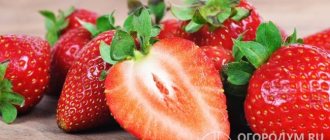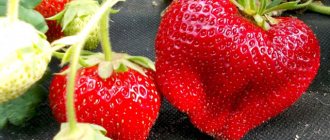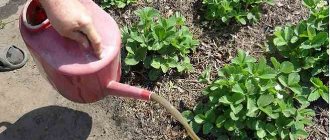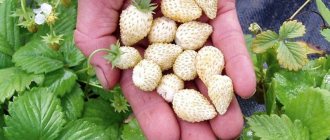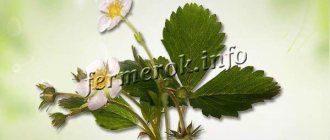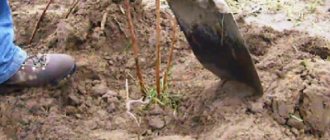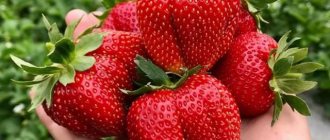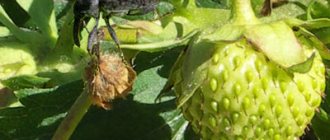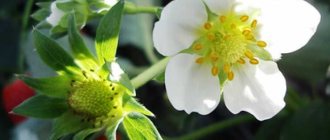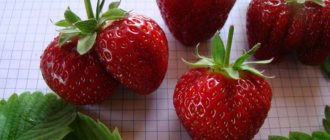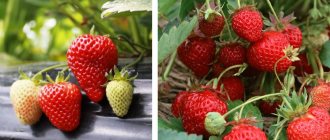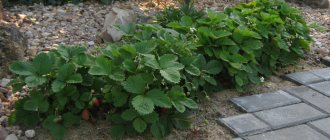Remontant varieties of strawberries are deservedly popular, as they yield twice a season. “Remontants” appeared on Russian territory about 20 years ago, and one of the first was the Ostara variety, which is valued for its high yields of sweet, aromatic fruits, but is not valued for its small fruits and very low transportability.
Description of Ostara strawberries
Strawberries of the Ostara variety are represented by small compact bushes, the height of which is about 25 cm. The leaves of the plants are dark green, and the leaf blade is covered with short fluff.
Despite the fact that the Ostara variety is considered large-fruited, in fact the bushes produce medium-sized fruits. On average, berries grow to 25-30 g with minimal care. When grown in fertile soils, the weight of the fruit increases to 65 g.
In appearance, Ostara strawberries resemble neat cones, as seen in the photo above. The surface of the fruit is smooth and shiny. The berries are uniformly colored bright red.
The aroma of ripened fruits is in many ways similar to the smell of wild strawberries. The berries taste sweet, but there is a pleasant sour aftertaste. According to the tasting assessment, the Ostara variety received 4.7 points out of 5.
The density of the fruit is low - Ostara strawberries form rather loose berries, which complicates transportation, however, they are very juicy.
Reviews from gardeners about the Ostara variety
Professional gardeners and amateurs generally speak positively about the Ostara variety, noting, first of all, the unusual taste of the berries, very similar to common wild strawberries.
Novice farmers talk about the simple planting procedure, while highlighting the need to annually update strawberry nests as the main drawback. A correctly chosen location guarantees high yields in the first season. There is little that can compare with large, bright scarlet berries with a strawberry aroma.
The main disadvantages of the Ostara variety are its short shelf life and low shelf life due to the soft structure of the fruit, as well as susceptibility to gray rot, which requires constant mulching of the soil . But still, many gardeners say that they will continue to grow this crop. Because the result is worth all the effort.
Characteristics of the variety
Ostara strawberries belong to the category of day neutral varieties. This means that when grown in open ground, it will bear fruit until the first frost. The ripening of fruits has nothing to do with the length of daylight hours. The intensity of fruiting is mainly determined by the level of soil moisture and air temperature, thanks to which the Ostara variety can be grown in greenhouse conditions throughout the year.
Main advantages
According to the description of Ostara strawberries, this variety, in addition to its high yield, is distinguished from others by its unpretentiousness in care and undemandingness to the composition of the soil. This allows it to be grown in most of Russia, even in the Northern regions.
The winter hardiness of the variety is average. Without additional shelter, the beds can withstand frosts from -10 to -15°C. However, if the winters in the growing region are quite snowy, the bushes will winter well even without insulation.
The drought tolerance of Ostara strawberries is low. This variety is quite moisture-loving, so lack of watering and long periods of heat are destructive for it. At temperatures above +28°C, the ability of plants to set new fruits sharply decreases.
Important! The shelf life of ripened berries is short, so they are quickly sent for processing or transported for sale.
Flowering period, ripening time, yield
Ostara strawberries are a remontant variety. This means that it bears fruit twice during the season, and the fruits are set both on the parent bushes and on the rooted tendrils.
The ability of the variety to form mustaches is average. It largely depends on what the plantings are fed with and how often fertilizers are added to the soil. The more nitrogen there is in the soil, the more tendrils the bush will throw out. On the other hand, an excess of nitrogen-containing fertilizers can cause the sweetness of the berries to noticeably decrease, giving way to increased acidity.
The yield of Ostara strawberries is about 1-1.2 kg per plant, however, the ability of the bushes to set fruit is rapidly declining. In order to maintain optimal yields, the beds must be updated every 1-2 years.
Important! Planting green manure in the beds helps increase productivity indicators. In particular, mustard is well suited for these purposes.
Scope of application (no more than 4-5 sentences)
The description of the Ostara remontant strawberry states that its scope is universal. The berries can be used to make preserves and jams, however, the bulk of the harvest is spent for fresh consumption. This variety is not very suitable for growing for sale, since the fruits cannot withstand long-distance transportation.
Resistance to diseases and pests
Ostara strawberries have excellent immunity. The variety is resistant to the vast majority of fungal infections and practically does not attract pests. The only exception is gray rot, which affects beds during periods of high humidity.
Advantages and disadvantages of the variety
The undeniable advantages of the Ostara variety include the following qualities:
- high yield rates;
- good adaptation abilities;
- undemanding to the composition of the soil;
- relative ease of care;
- good tasting assessment of fruits;
- pleasant aroma of wild strawberries;
- the variety bears fruit 2 times per season;
- average winter hardiness;
- excellent resistance to fungus and pests.
Based on reviews, the disadvantages of remontant strawberries Ostara include the following features of the variety:
- bushes quickly age as a result of abundant fruiting - plantings can be renewed within a year;
- looseness of berries - strawberries are unsuitable for transportation over long distances;
- moisture-loving - the variety does not tolerate even short-term drought and heat;
- vulnerability to gray mold.
Important! Another advantage of the variety is the fact that Ostara strawberries can be used as a productive pollinator for other remontant varieties.
Reproduction methods
Ostara strawberries are not propagated by seed. It retains its varietal qualities only under conditions of vegetative propagation by dividing bushes and rooting mustaches.
The easiest way to propagate strawberries of the Ostara variety is with tendrils - rooting of discarded shoots most often occurs even without human intervention. The very first tendrils that form on young bushes are the most productive. In order to grow seedlings from the resulting daughter bushes, a special container or glass with soil mixture is dug into the ground. A mustache with a rosette of leaves is pinned into them. After 60 days, the seedlings will form a sufficiently developed root system, after which the resulting seedlings can be transplanted to new places.
By dividing bushes, old plantings are often rejuvenated. The reproduction process occurs according to the following scheme:
- The strawberry bush is dug up and divided into 2-3 equal parts. Each division must have a growing point, developed roots and at least 3 leaves.
- The old base is thrown away or burned; it is no longer suitable for cultivation.
- The resulting divisions are transplanted to new places.
Reviews
Veronica. I have been growing Ostara for a long time and have no plans to give it up, although most of my strawberry beds are occupied by other varieties. To make the berries larger, I remove some of the peduncles and tendrils throughout the season. In total I have 30 bushes, enough berries to eat and close. Ostara jam is incredibly tasty and aromatic. I renew the plantings every 3 years, but at the same time there is no particular hassle with the variety, it is not demanding and unpretentious. Of the pests, only slugs are dangerous; you need to set traps.
Alexei. In the case of Ostara, you have to choose - either a good harvest or a mustache. I leave a small part of the tendrils and cut them off as soon as the new rosette takes root. In the Tula region, the variety overwinters well without shelter, but the beds cannot be left without mulch, otherwise the berries are massively affected by gray rot. I grow this variety because of the special taste and aroma of the fruit; I have not yet found any analogues. The largest berries are those that ripen first on the peduncle, the rest will be a little smaller.
Landing rules
Planting remontant strawberries of the Ostara variety is not difficult. Planting dates depend on when the harvest is planned. In order to harvest in the spring, seedlings are planted in late July. This way, the plants will have time to take root and form a sufficient number of buds.
If strawberries are planted for the purpose of obtaining an autumn harvest, the planting dates are shifted to the end of August - the beginning of autumn; seedlings can also be planted in the spring. The most important thing is to promptly remove the flowers that appear at the beginning of the season. Thus, the bushes will save their strength for the autumn harvest.
Important! The best place to plant strawberries is in a sunny place where there used to be beds of garlic, onions or peas. Areas previously used for growing tomatoes and cabbage may contain disease spores that are dangerous to the variety.
Strawberry seedlings of the Ostara variety are grown according to the following algorithm:
- The soil is sifted through a sieve and doused with boiling water for disinfection.
- Seeds are kept in the refrigerator for 30 days (not in the freezer).
- The sown planting material is lightly sprinkled with dry soil and covered with polyethylene or glass.
- The container with seedlings is placed in a dry, well-lit room.
- As soon as the seedlings form 3 true leaves, they are picked and begin to harden.
Once the threat of the last frost has passed, strawberries can be planted. Usually this is the first ten days of May.
Strawberry seedlings are planted according to the following scheme:
- The area for future beds is spilled with a warm solution of potassium permanganate.
- Holes are dug in the ground with a depth of no more than 10-12 cm. The recommended distance between holes is 45-50 cm.
- Humus or compost mixed with wood ash is placed at the bottom of each hole. You can also use complex fertilizers.
- The seedlings are carefully lowered into the holes and sprinkled with earth.
- Planting is completed with watering, for which the Epin solution is used.
- To prevent fungal diseases, the plantings can be watered the next day with a solution of Fitosporin.
Important! To prevent moisture from stagnating in the soil, it is recommended to plant Ostara strawberries on level areas. It is better not to place beds in lowlands.
Features of remontant strawberry varieties
Since remontant strawberry varieties are still a relative innovation in Russia, not everyone still correctly understands the characteristics of these varieties and what proper care for them involves. There is also some confusion among amateur gardeners about the differences between remontant strawberries and day-neutral varieties. The fact is that in the USA it is not customary to distinguish between these varieties and all remontant varieties are automatically called day-neutral varieties, which is not entirely true.
In fact, strawberries have three main varieties based on their sensitivity to daylength:
- Short day plants.
- Long day or long day plants.
- Day neutral plants.
The first group is the easiest to understand; it automatically includes all the usual traditional varieties that have the ability to lay flower buds only when daylight is 12 hours or less. This happens just at the end of summer - beginning of autumn, when a decrease in general temperatures also has a beneficial effect on the general process of laying buds for fruiting in the next season.
Strawberries of the second group are capable of forming flower buds only when the day length is more than 12 hours, ideally about 16-18. For this reason, varieties of this group manage to produce two and sometimes three waves of fruiting during the warm season.
The fruiting of day-neutral strawberries, as the name implies, is not at all tied to the length of daylight hours and can only be determined by temperature and humidity conditions. That is why these strawberry varieties are very convenient to grow in heated greenhouses all year round.
The term remontance simply determines the ability of plants to bear fruit more than once per season. Thus, both long-day strawberries and neutral-day strawberries can rightfully be called remontant.
But there are not so many varieties of long-day strawberries compared to the number of varieties from the third group. And they are not very suitable for growing in year-round greenhouses. But the life expectancy of long-day strawberry bushes is, as a rule, much longer than that of a neutral day. They can be grown in one place for up to two to three years, while day-neutral varieties, due to intensive constant fruiting, quickly exhaust their resources and must be replaced approximately a year after the start of fruiting.
All remontant varieties, and especially those belonging to the day-neutral group, require the use of higher agricultural technology, since they spend a lot of energy on constant fruit set. But they are usually more adaptable and resistant to adverse weather conditions and various diseases. In addition, berries of almost any remontant variety have an attractive taste and aesthetic appearance.
Aftercare
Caring for Ostara strawberries includes the most basic procedures:
- weeding;
- regular loosening;
- watering and fertilizing.
To better retain moisture in the soil, plantings can also be mulched. Moreover, a layer of mulch prevents the growth of weeds, due to which the frequency of weeding is noticeably reduced. Sawdust, straw or peat are used as a mulching layer.
The plantings are watered regularly, since Ostara is a moisture-loving variety; however, the beds should not be flooded. Stagnation of water in the soil is detrimental to the root system of plants. In addition, high humidity can provoke the development of gray rot. To avoid sunburn on strawberry leaves, it is recommended to organize drip irrigation of the beds.
Strawberry fertilizer is produced at the beginning of flowering and during the fruiting period. Fertilizers made from herbal infusions have proven themselves well. For these purposes, wormwood, yarrow and nettle are collected, the leaves of the plants are finely chopped and filled with warm water. The green mass is infused for 5-7 days, after which the infusion is ready for use.
During fruit set, strawberries can be fed with an infusion based on chicken manure. To do this, 1 kg of fertilizer is diluted in 15 liters of water.
Advice! It is recommended to alternate organic fertilizers with mineral ones.
Preparing for winter
For winter, Ostara strawberries are prepared according to the following scheme:
- In autumn, yellowed leaves are trimmed from bushes.
- The exposed plant roots are covered with soil, after which a small amount of fertilizer is added to the soil.
- Then the beds are mulched. To do this, you can use dry grass and leaves, peat, humus or sawdust, which must first be soaked in boiled water. The recommended thickness of the mulch layer is 10 cm.
Important! When mulching plantings, sprinkle only the row spacing. Strawberry leaves cannot be covered with mulch, otherwise the plants will wither when it gets warmer.
Features of cultivation
Ostara is characterized by a shortened life cycle, this feature is most pronounced in the southern regions. If in the first season after planting a variety produces the maximum number of fruits, it may well happen that the variety immediately degenerates. Next year the berries will be too small and bland. How to make sure that the bushes produce a harvest of large and tasty fruits over 2 seasons? Now we'll tell you.
The best way to grow Ostara strawberries:
- For good development, the variety needs to be allocated an open place with fertile, non-acidic and loose soil. In lowlands and in places where moisture lingers for a long time, the variety is not planted;
- The site is prepared in the fall (digging, fertilizing and marking rows). Planting should be done in the spring, after returning frosts. At the first stage of growth, strawberries need to be provided with partial shade, since it is usually hot in May. The distance between bushes and rows is 30 cm;
- Near Ostara you need to plant several bushes of the Eva variety; such a tandem will be the most successful. But they need to be placed away from other varieties of crops to avoid misgrading;
- The first peduncles are usually removed from all varieties; the bush must become completely strong. The same method provides for the almost complete removal of flowers in the first year of cultivation. Thus, by the next season the bushes will be strong and produce a sufficient number of mustaches;
- Watering is carried out once a week, and even less frequently from August. Feeding is not needed in the first season;
- Ostara can winter without shelter, in snowy winters, when the temperature does not drop below 17 degrees. In this case, the foliage is not removed in the fall; it can be carefully raked in early spring. In cold regions, the variety is covered with a small layer of straw or any other available material. Covering too early or too tightly can lead to damping off;
- In the second year, Ostara will produce maximum yield; the fruits will be large, causing the flower stalks to fall to the ground. To prevent the berries from rotting and getting dirty, the beds are covered with mulch. During this season, watering and fertilizing are carried out frequently. Peduncles are removed from the stepchildren, as was done in the first year with the mother bushes;
- In the third year, the harvest will also be good, but the berries will become a little smaller. The largest specimens may slightly lose their taste in rainy weather. This season, you can begin to select the strongest stepsons of the first and second years for transplantation.
Thus, we get a good harvest of Ostara garden strawberries for 2 years, and we will also have our own good planting material for renewing the plantings. Another point - the berries should not hang on the bushes for a long time; when ripe, they should be picked immediately. This way the plant will have enough strength to form new flower stalks and ovaries.
Finally, we note the high decorativeness of Ostara garden strawberries. The bush continuously blooms and bears fruit from late spring until late autumn. The variety is often used to decorate the area, especially since it grows well in pots and other containers.
Disease and pest control measures
In general, Ostara strawberries are quite resistant to various diseases, however, a number of diseases pose a serious danger to them, namely:
- gray rot;
- brown spot;
- powdery mildew.
Gray rot affects beds when moisture stagnates in the soil, which occurs as a result of thickening of plantings and improper organization of watering. An outbreak of the disease can destroy 50 to 70% of the crop.
Prevention measures:
- To avoid thickening of plantings, the variety is planted strictly according to the recommended scheme. This way, the plants will be sufficiently ventilated.
- The beds are mulched so that parts of the plants do not touch the ground.
- For fertilizing, use a minimum amount of nitrogen-containing fertilizers. Thus, the bushes will not gain green mass, which usually leads to thickening of the plantings.
- In order to reduce the risk of disease to a minimum, plants are sprayed with a 3% solution of Bordeaux mixture and a 1% solution of colloidal sulfur.
If gray rot does affect the strawberries, the plants are sprayed with fungicides. The drugs “Kaptan” and “Strobi” have proven themselves well.
Brown spotting is provoked by sudden temperature changes and high air humidity. Prevention of the disease comes down to timely removal of dry leaves and mulching of the soil under the plants. Plants are treated with the fungicides “Fundazol” and “Strobi”.
Powdery mildew also actively develops in conditions of high air humidity. The first sign of the disease is a white coating on the leaves of plants. To combat the disease, strawberries are sprayed with Topaz or Strobi.
The most dangerous pests of Ostara strawberries include the following insects:
- strawberry mite;
- spider mite;
- strawberry nematode.
To combat these pests, use a Karbofos solution. At the first signs of nematode damage, diseased strawberry bushes are dug up and burned away from the site.
Advantages and disadvantages
The advantages are noted:
- early onset of fruiting;
- long fruiting;
- high yield rates;
- pleasant taste and aroma;
- the fact that the growth and fruiting of the variety does not depend on the length of daylight hours;
- good resistance to disease.
Flaws:
- not transported or stored;
- it is necessary to update plants frequently;
- there is a risk of gray mold disease.
All the advantages and disadvantages of growing strawberries
Planting Dutch strawberries will become a curiosity in your garden plot. Throughout the summer and early autumn, the summer resident will be able to eat healthy, tasty berries. The advantages of Ostara include:
- High gastronomic characteristics of ripe fruits.
- High yield.
- Resistant to most types of fungal diseases.
- Good winter hardiness in areas with snowy winters.
- Large fruit.
- Easy to grow and propagate.
Among the disadvantages of the variety are:
- Average drought resistance; in hot and prolonged heat, additional watering is necessary, otherwise the yield is significantly reduced.
- No long storage period, not suitable for transportation.
- Susceptible to gray rot.
- In areas with harsh winters, additional winter shelter is required.
- Plantings must be regularly rejuvenated.
Excessive watering of strawberry plantings and stagnation of moisture at the roots of plants is undesirable. The berries become watery, sink to the ground and begin to rot.
